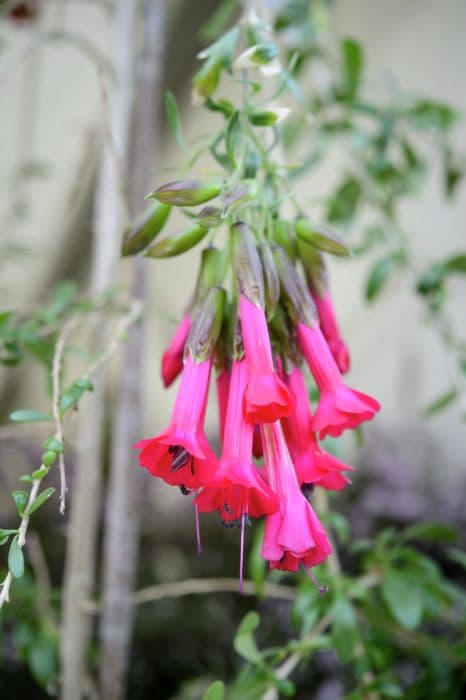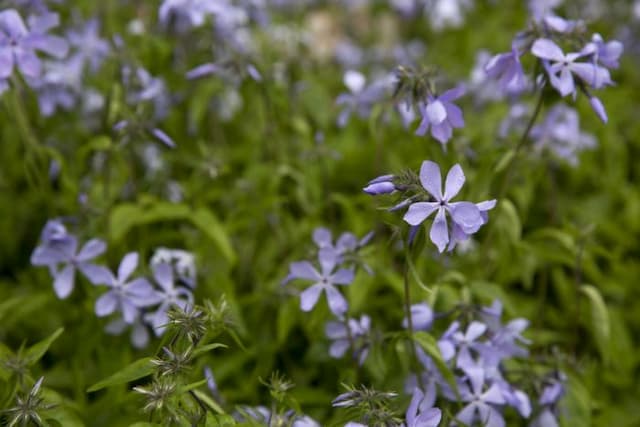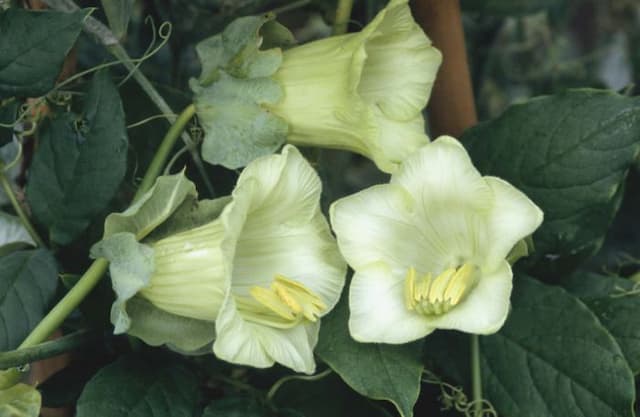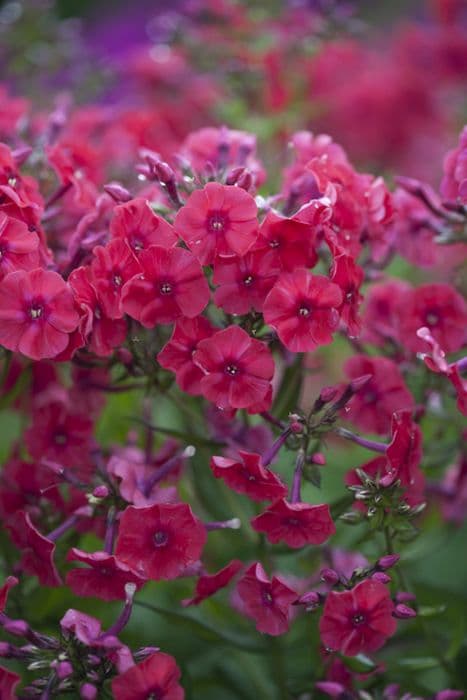Globe Gilia Gilia capitata






ABOUT
Gilia capitata is commonly referred to as blue-thimble-flower. It's known for its remarkably attractive floral display. The plant bears rounded clusters of small flowers that appear to be shaped like tiny thimbles. These blossoms exhibit a range of colors from a deep, vibrant blue to a lighter, almost lavender shade, adding a burst of color to the landscape it graces. The foliage of the blue-thimble-flower consists of numerous, thin leaves that surround the base of the plant. These leaves are delicate and finely divided, lending a feathery or fernlike appearance to the greenery. As the flowers bloom, they sit atop slender yet sturdy stems that rise above the rosette of leaves, giving the impression of a bouquet of blue balls held aloft on airy stalks. The plant exudes a wildflower charm, often swaying gently in the breeze and attracting pollinators such as bees and butterflies, which are enticed by the rich nectar and pollen. The blue-thimble-flower is a testament to the natural beauty found in wildflower species and serves as an excellent choice for gardeners looking to create a cottage garden feel or to support local wildlife with native flowering plants.
About this plant
 Names
NamesFamily
Polemoniaceae
Synonyms
Globe Gilia, Bluehead Gilia, Blue Field Gilia, Thimble Flower, Queen Anne's Thimble
Common names
Gilia capitata var. chamissonis, Gilia capitata var. pacifica, Gilia capitata var. tomentosa.
 Toxicity
ToxicityTo humans
Blue thimble flower, scientifically known as Gilia capitata, does not commonly present any significant toxic threats to humans. There is no widespread evidence suggesting that this plant is poisonous to people, nor are there well-documented symptoms of poisoning from ingesting it. However, as with any plant, individual allergic reactions can occur, and it is generally advisable to exercise caution and avoid eating any plant part unless it is known to be safe.
To pets
Blue thimble flower, or Gilia capitata, is not widely known to be toxic to pets. There is limited information on the potential harmful effects of this plant when ingested by animals, but no substantial evidence suggests severe toxicity or poisoning. As with humans, pets can have individual allergic reactions to plants, and it's typically best to prevent them from ingesting plants that are not specifically intended for animal consumption.
 Characteristics
CharacteristicsLife cycle
Annuals
Foliage type
Deciduous
Color of leaves
Green
Flower color
Blue
Height
1-3 feet (0.3-0.9 meters)
Spread
1 foot (0.3 meters)
Plant type
Herb
Hardiness zones
3-9
Native area
California
Benefits
 General Benefits
General Benefits- Attracts pollinators: Gilia capitata, commonly known as Bluehead Gilia, is known to attract bees, butterflies, and other pollinators, which can enhance pollination in the garden or natural area.
- Drought-tolerant: Once established, Bluehead Gilia is drought-tolerant, making it suitable for xeriscaping and water-wise gardening practices.
- Erosion control: The plant's root system helps stabilize the soil, making it useful for erosion control on slopes and in areas prone to soil degradation.
- Aesthetic appeal: With its blue-violet flowers and delicate foliage, Bluehead Gilia adds visual interest and color to gardens and wildflower meadows.
- Native habitat support: As a native North American wildflower, Bluehead Gilia supports local ecosystems and provides habitat for native fauna.
- Easy to grow: Bluehead Gilia is known for being easy to cultivate from seed, making it a good choice for novice gardeners or those looking for low-maintenance plants.
 Medical Properties
Medical PropertiesThis plant is not used for medical purposes.
 Air-purifying Qualities
Air-purifying QualitiesThis plant is not specifically known for air purifying qualities.
 Other Uses
Other Uses- Globe Gilia, as a native plant, can be used for restoration projects to rehabilitate disturbed land and support local ecosystems.
- Dye Production: The plant's flowers might be used to create a natural dye for coloring textiles or craft materials.
- Educational Tool: Globe Gilia can be included in educational gardens or programs to teach about native flora and pollinator-friendly practices.
- Garden Aesthetics: With its striking blue flowers, it's an appealing addition to ornamental gardens that aim for a wildflower look.
- Art and Crafts: The flowers of the Globe Gilia can be pressed and included in craft projects like handmade cards or bookmarks.
- Floristry: Its delicate, ball-shaped clusters of flowers may be used in fresh or dried floral arrangements.
- Photography Subject: Globe Gilia provides a photogenic subject for photographers specializing in botanical and landscape imagery.
- Companion Planting: Globe Gilia could serve as a companion plant in vegetable gardens, attracting beneficial insects that could help with pest control.
- Culinary Decoration: Although not commonly consumed, the flowers could potentially be used as an edible garnish for salads or desserts after ensuring they are safe and non-toxic.
- Wildlife Gardening: Planting Globe Gilia can create habitats for local wildlife, particularly pollinators like bees and butterflies.
Interesting Facts
 Feng Shui
Feng ShuiThe Gilia capitata, commonly known as Globe Gilia, is not used in Feng Shui practice.
 Zodiac Sign Compitability
Zodiac Sign CompitabilityThe Globe Gilia is not used in astrology practice.
 Plant Symbolism
Plant Symbolism- Attraction: Gilia capitata, commonly known as Globe Gilia, has plentiful, spherical clusters of flowers that symbolize a magnetic charm or allure.
- Airy Nature: Globe Gilia's delicate and feathery foliage represents lightness and an easygoing character, much like the breezes that sway it.
- Connection to the Wild: As a plant that thrives in natural settings like prairies, Globe Gilia is often symbolic of a strong connection to wild, open spaces.
- Harmony with Wildlife: With its appeal to butterflies, Globe Gilia represents the symbiotic relationships and harmony between plants and wildlife.
- Perseverance: Globe Gilia's ability to grow in challenging conditions suggests a symbolism of resilience and perseverance in adversity.
 Water
WaterThe Globe Gilia requires moderate watering, especially during its growing season in the spring and summer. It's best to water it once a week, providing enough water to moisten the soil without causing waterlogging, which would be approximately 1 gallon for an average-sized plant in a garden setting. During hot, dry spells, watering frequency should increase, but always check the soil moisture before watering to avoid over-saturation. In the fall and winter, reduce watering since the plant's water needs decrease during dormancy.
 Light
LightGlobe Gilia thrives in full sun conditions where it can receive at least 6 to 8 hours of direct sunlight daily. The ideal spot for planting Globe Gilia would be in a south-facing garden or an area where it's exposed to ample sunlight throughout the day. However, it's also adaptable to partial shade, especially in regions with very intense sun.
 Temperature
TemperatureGlobe Gilia is best suited to temperate climates with an ideal temperature range between 60°F and 75°F. It can survive minimum temperatures down to about 20°F and maximum temperatures up to around 90°F. However, it is not frost-tolerant and may require protection or mulching when temperatures dip below freezing.
 Pruning
PruningPruning Globe Gilia is generally done to remove spent flowers and encourage a second bloom. Deadhead the flowers after the first bloom has faded, usually in mid-summer, to stimulate re-blooming. Minimal pruning is required; simply cut back the flowering stems by a few inches. The best time for pruning is shortly after the first flowering ends.
 Cleaning
CleaningAs needed
 Soil
SoilThe Blue Thimble Flower thrives best in well-draining soil with a neutral to slightly alkaline pH, ideally between 6.5 to 7.5. A mix of loam, sand, and a small amount of compost is suitable for this plant, ensuring adequate drainage and nutrients.
 Repotting
RepottingThe Blue Thimble Flower is typically grown as an annual and therefore does not usually require repotting. If started in containers, transplant them outdoors after the risk of frost has passed.
 Humidity & Misting
Humidity & MistingThe Blue Thimble Flower prefers moderate humidity levels but is quite adaptable and can tolerate the varying conditions found in most natural outdoor environments.
 Suitable locations
Suitable locationsIndoor
Ensure bright light, mild temperatures, and air circulation.
Outdoor
Plant in full sun with well-draining soil after frost danger.
Hardiness zone
3-9 USDA.
 Life cycle
Life cycleGilia capitata, commonly known as Globe Gilia or Blue Thimble Flower, begins its life cycle as a seed that germinates in late winter to early spring when moisture and temperature conditions are suitable. Emerging as seedlings, they develop a rosette of basal leaves while establishing their root systems. As they grow, a flower stalk elongates, and between spring and summer, Globe Gilia produces spherical clusters of small blue flowers that attract pollinators such as bees and butterflies. After pollination, the flowers develop into seed capsules that release seeds once they mature and dry, often by late summer or fall. These seeds then enter a period of dormancy through the winter months until environmental conditions trigger the next cycle of germination. The plant is typically annual but can behave as a biennial in some conditions, meaning it may complete its life cycle in one or two years.
 Propogation
PropogationPropogation time
Spring to Summer
Gilia capitata, commonly known as Globe Gilia, is most commonly propagated by seed. The ideal time to sow seeds is in the fall, allowing them to overwinter and germinate in the spring. Surface sow the seeds directly onto a well-drained soil mix, ensuring that they are not covered as they require light to germinate. Keeping the soil moist but not waterlogged is important during the germination period. Once the seedlings emerge and develop true leaves, they can be thinned and eventually transplanted to their desired location in the garden. Seed propagation not only is straightforward but also helps maintain the genetic diversity of the Globe Gilia population.









